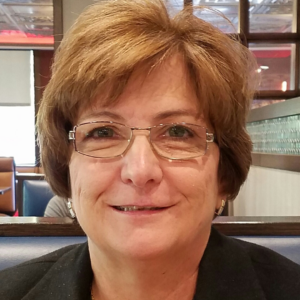2016 Leaders of Tomorrow: Awa Diouf
Awa Diouf’s personal arsenal includes cloth, wood, string, paint and anything she thinks she can repurpose. But the activities she creates for the memory care residents at The Residence at Watertown Square, Watertown, Mass., aren’t just for fun—there’s a deep, 3-D purpose behind every one of them.
As the assistant of resident engagement, she’s a fountain of ideas, some of them stemming back to her teens when she worked with children in her native country of Senegal and her years of volunteering for the YMCA’s programs for children with disabilities.
Instead of separating the residents into different activity groups based on abilities, she groups them by interest and lets each resident do whatever task matches his or her function level. While making a batch of stuffed toy snowmen, a resident who enjoys small handwork might glue on the eyes, while a resident who needs a role requiring less accuracy might eagerly take on the stuffing job.
Diouf’s mixed-ability groups have even sewn dresses, shirts and capes to wear, with some residents pinning the cloth pieces together while others take turns running the sewing machine’s foot pedal. Some enjoy the sewing machine action a bit too much: “I have to give them speeding tickets,” she jokes.
 Diouf’s projects are much more than the materials they come from. They’re complex, interleaved levels of personal memories, social interaction and teamwork to create something for someone else. Right now, the residents are turning a wooden crate into a dollhouse. As the residents work together to add new things to the diorama, each tiny room prompts memories of home and what activities of daily living take place in each room. Most of the materials are recycled. A toilet paper tube becomes a tiny toilet for the bathroom. A thread spool and a candy wrapper become a bedroom lamp.
Diouf’s projects are much more than the materials they come from. They’re complex, interleaved levels of personal memories, social interaction and teamwork to create something for someone else. Right now, the residents are turning a wooden crate into a dollhouse. As the residents work together to add new things to the diorama, each tiny room prompts memories of home and what activities of daily living take place in each room. Most of the materials are recycled. A toilet paper tube becomes a tiny toilet for the bathroom. A thread spool and a candy wrapper become a bedroom lamp.
The dollhouse is destined to be given as a gift to a local children’s hospital, giving the residents a sense of purpose in their efforts. When it’s time to deliver it, Diouf will take able residents of “The Dollhouse Club” with her, allowing them to experience the gift-giving part of the project. The photos they’ll take will be used in a scrapbook story as a reminder of the project’s full circle. “Those become new memories,” she says.
Diouf is a strong believer in the culture change surrounding memory care programming and its shift from merely keeping residents occupied to finding ways to engage them on multiple levels with every activity, all day long. It’s a way of exercising life skills like hand-eye coordination and combining memories of the past with current experiences, but it’s also a way to involve resident choices at every step in the process. True engagement, Diouf says, strives to exercise the brain’s ability to form and express ideas, to be creative and to share those experiences with others. “I want them to feel that whatever they do is useful,” she says. “You can see their self-esteem go up and see how proud they are of what they are doing, knowing somebody is going to use it.”
A few weeks ago, the residents in the sewing club made cosmetic bags and personalized each one with a specific resident’s initials to give as gifts. “One resident came up to a member of the sewing club and said, ‘Look, I’m using my bag!’ She had put her hair brush and candy in it,” Diouf says. “So the residents feel like they did something for someone else, and it makes them feel like they belong.”
Activities programming isn’t all arts and crafts, either. Diouf encourages every resident in the memory care center to read a newspaper of their choice each morning, and after breakfast it’s time for physical exercises—often the bane of activity programmers. But Diouf mixes it up to keep the participation level high. “Some mornings we do chair yoga or aerobics, and some mornings we do exercise with light weights, foam or stretch bands. It’s all about getting them moving.”
She’s always trying out new exercises, and after each exercise session, she asks each resident for feedback. “I ask them, ‘How do you feel about what we’ve done today?’ They give me their opinion on what they want me to improve or what they want me to not to do anymore, because they’re all different physically,” she says. “Yesterday, one of the residents told me, ‘I feel like my shoulder is weak, and I need something I can do to make it stronger without hurting myself.’ It’s very important to have their feedback.”
Using the approach of combining resident abilities in activities can succeed if you invest the time in getting to know each resident’s skills and interests, she says. As individuals, some will work well in smaller, topic-related groups while others will like to do activities at certain times of the day or in certain places. “You have to get to know them and learn what their strengths are and what triggers their difficulties,” she says. “And, if any resident has trouble, I have their back.”
The dollhouse is well outfitted now, but the residents haven’t decided it’s done yet, she says. "They keep wanting to add something else."

Pamela Tabar was editor-in-chief of I Advance Senior Care from 2013-2018. She has worked as a writer and editor for healthcare business media since 1998, including as News Editor of Healthcare Informatics. She has a master’s degree in journalism from Kent State University and a master’s degree in English from the University of York, England.
Related Articles
Topics: Activities , Alzheimer's/Dementia , Articles , Leadership











